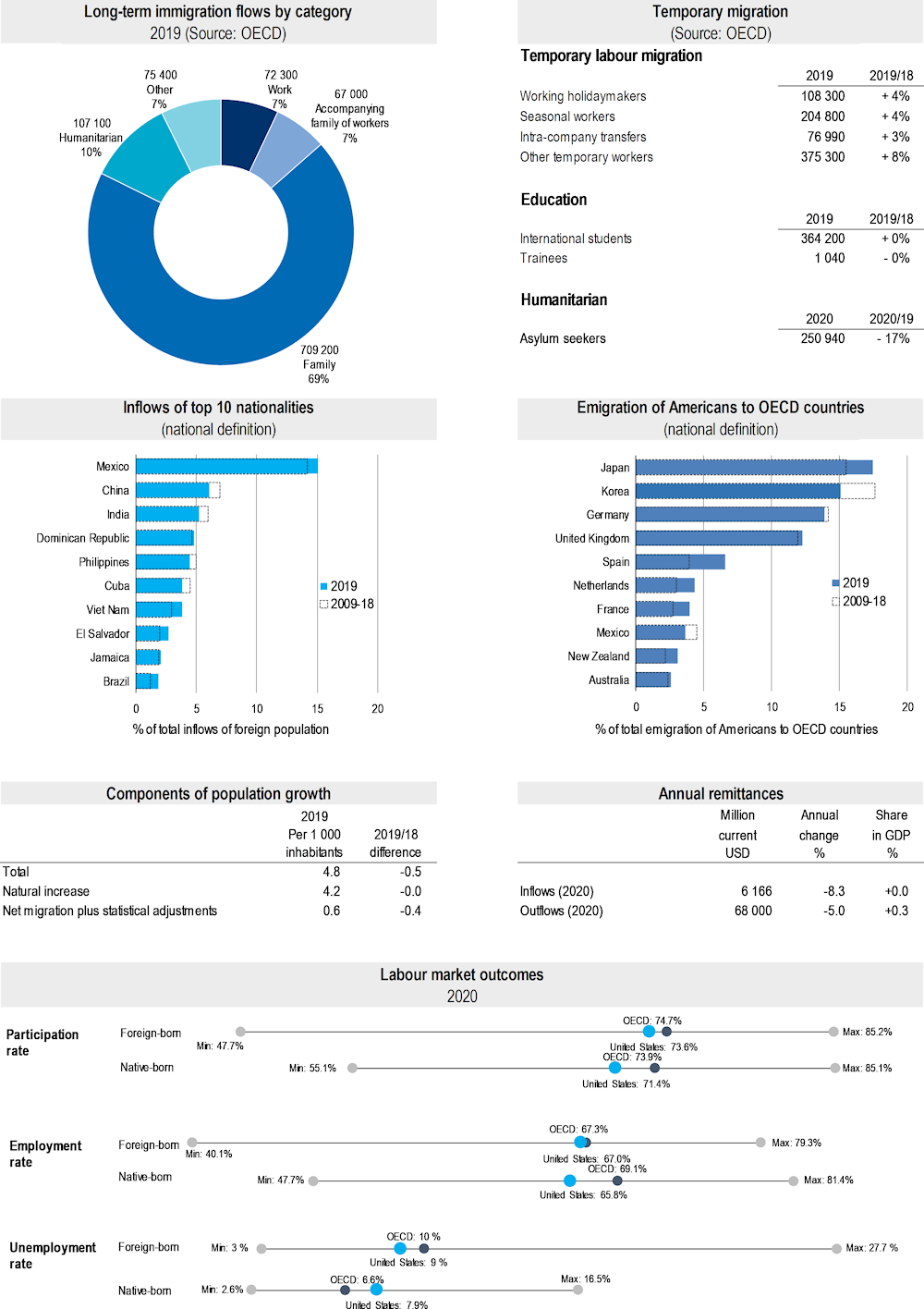In 2019, the United States received 1031 000 new immigrants on a long-term or permanent basis (including changes of status), ‑6% compared to 2018. This figure comprises 7% labour migrants, 75.3% family members (including accompanying family) and 10.4% humanitarian migrants. Around 364 000 permits were issued to tertiary-level international students and 766 000 to temporary and seasonal labour migrants.
Mexico, China and India were the top three nationalities of newcomers in 2019. Among the top 15 countries of origin, Viet Nam registered the strongest increase (5 800) and Cuba the largest decrease (‑36 000) in flows to the United States compared to the previous year.
In 2020, the number of first asylum applicants decreased by ‑16.6%, to reach around 251 000. The majority of applicants came from Guatemala (36 000), Honduras (31 000) and Venezuela (24 000). The largest increase since 2019 concerned nationals of Haiti (3 200) and the largest decrease nationals of Guatemala (‑15 000). Of the 94 000 decisions taken in 2020, 17.3% were positive.
Emigration of Americans to OECD countries decreased by ‑5% in 2019, to 113 000. Approximately 21% of this group migrated to Japan, 15% to the United Kingdom and 9% to Germany.
Following an administration change, US government agencies, including the Department of Homeland Security (DHS), were tasked with reviewing their policies and processes to ensure a safe, orderly and humane immigration system. Executive Orders and Proclamations signed by President Biden outlined efforts to restore US commitment to welcoming refugees, respond to the situation at the US Southern border, reduce barriers to legal immigration and promote citizenship and integration.
The Migrant Protection Protocols were suspended, and DHS has resumed processing of individuals who had been returned to Mexico for the duration of their immigration proceeding. Efficient intake of unaccompanied children at the US-Mexican border is a policy priority.
The United States returned to previous guidance on the public charge inadmissibility provision following a court order vacating the 2019 final rule on Inadmissibility on Public Charge Grounds. US government agencies are now focused on engagement with the public, stakeholders, and benefits-granting agencies to advance education and awareness regarding the public charge rules, particularly with respect to public health in light of COVID‑19 and ongoing vaccination efforts.
In December 2020, DHS announced it would review new applications for Deferred Action for Childhood Arrivals (DACA) according to the original eligibility conditions of 2017. One‑year approvals and associated work authorisation issued between July and December 2020 will be extended an additional year.
COVID‑19 impacted nearly every aspect of the immigration system and DHS responded to the pandemic by finding alternatives to traditional in-person processes to maintain operations while abiding by public health guidance, including with the use of video technology where possible.
Removals continued throughout 2020, but the United States introduced exceptional measures for individuals impacted by COVID‑19. In August 2020, DHS published a temporary rule to reduce uncertainty in agricultural production, permitting petitioners with a valid temporary certification to employ temporary workers (H‑2A) pending final approval. The rule also allowed temporary workers to change employers.
DHS announced filing flexibilities in response to COVID‑19, including extended response times to requests for evidence and deadlines for appeal of an adverse decision. Additionally, delays due to COVID‑19 may excuse failure to make a timely request for extension or change of status. Visa Waiver Program (VWP) entrants facing a COVID-related emergency may seek a 30‑day extension to depart.
DHS introduced measures to offset delays in processing employment authorisation applications, including allowing F‑1 student applicants for optional practical training (OPT) to complete OPT within the 14‑month period after approval of work authorisation rather than from date of the end of their programme (for applications through 1 May 2021).
For further information:

